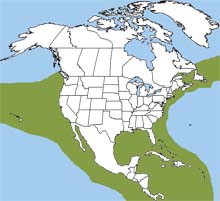Description
 The short-beaked saddleback dolphin is a small, slender dolphin between 5-8 feet in length. Females are usually smaller than males. It has a long, sharp beak; a triangular dorsal fin; and
triangular flippers with pointed tips. It has a black or brownish-gray back, and a creamy white underside. It has a dark streak runs from its lower jaw to its flipper. Its sides are marked with
an hourglass or crisscross pattern of
light gray, yellow, or tan bands.
The short-beaked saddleback dolphin is also known as the common dolphin, the saddle-backed dolphin, the hourglass dolphin, or the
crisscross dolphin. The short-beaked saddleback dolphin is a small, slender dolphin between 5-8 feet in length. Females are usually smaller than males. It has a long, sharp beak; a triangular dorsal fin; and
triangular flippers with pointed tips. It has a black or brownish-gray back, and a creamy white underside. It has a dark streak runs from its lower jaw to its flipper. Its sides are marked with
an hourglass or crisscross pattern of
light gray, yellow, or tan bands.
The short-beaked saddleback dolphin is also known as the common dolphin, the saddle-backed dolphin, the hourglass dolphin, or the
crisscross dolphin.
Range
 The short-beaked saddleback dolphin is found in tropical to cool temperate waters of the Atlantic and Pacific oceans. In North America, it is found in the
Atlantic Ocean from Newfoundland and Nova Scotia to northern South America as well as in the Gulf of Mexico and in the Pacific Ocean from Victoria, British Columbia to the equator. The short-beaked saddleback dolphin is found in tropical to cool temperate waters of the Atlantic and Pacific oceans. In North America, it is found in the
Atlantic Ocean from Newfoundland and Nova Scotia to northern South America as well as in the Gulf of Mexico and in the Pacific Ocean from Victoria, British Columbia to the equator.
| |
Habitat
The short-beaked saddleback dolphin is usually found in offshore coastal waters, but it is also found in the open sea.
Diet
 The short-beaked saddleback dolphin feeds in groups and eats as much as 20 pounds of food a day. It eats small fish like
herring, pilchard, anchovies, nocturnal hake, and sardines. Dolphins will work together to herd the fish into tight groups to make it easier to catch their prey. They also eat squid and octopus. The short-beaked saddleback dolphin feeds in groups and eats as much as 20 pounds of food a day. It eats small fish like
herring, pilchard, anchovies, nocturnal hake, and sardines. Dolphins will work together to herd the fish into tight groups to make it easier to catch their prey. They also eat squid and octopus.
Life Cycle
 The female gives birth to one baby, 10-12 months after mating. When it is about six months old, the baby dolphin begins to feed on fish, but it continues to nurse for another year. Young dolphins remain with their family group. The female gives birth to one baby, 10-12 months after mating. When it is about six months old, the baby dolphin begins to feed on fish, but it continues to nurse for another year. Young dolphins remain with their family group.
Behavior
 The short-beaked saddleback dolphin is a very social animal and lives in large pods or groups. The pods usually have from
20 to several hundred members, but pods can contain thousands of dolphins! Short-beaked saddleback dolphins are fast swimmers and like to ride on waves! The short-beaked saddleback dolphin is a very social animal and lives in large pods or groups. The pods usually have from
20 to several hundred members, but pods can contain thousands of dolphins! Short-beaked saddleback dolphins are fast swimmers and like to ride on waves!
|


 The short-beaked saddleback dolphin is found in tropical to cool temperate waters of the Atlantic and Pacific oceans. In North America, it is found in the
Atlantic Ocean from Newfoundland and Nova Scotia to northern South America as well as in the Gulf of Mexico and in the Pacific Ocean from Victoria, British Columbia to the equator.
The short-beaked saddleback dolphin is found in tropical to cool temperate waters of the Atlantic and Pacific oceans. In North America, it is found in the
Atlantic Ocean from Newfoundland and Nova Scotia to northern South America as well as in the Gulf of Mexico and in the Pacific Ocean from Victoria, British Columbia to the equator. 

